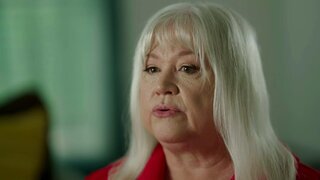Create a free profile to get unlimited access to exclusive videos, breaking news, sweepstakes, and more!
‘I Didn’t Do It!’ Texas Wife Yells In Court — Was Her Husband's Death Murder Or Suicide?
A devoted son was convinced his imprisoned mom, Susie Mowbray, didn’t kill his stepdad. Did the jury at her retrial agree?
Brownsville, Texas is known as a peaceful place. But on the night of September 16, 1987, the serenity was shattered by the blast of a gun and a prominent resident’s 911 call.
Susie Mowbray made the cry for help to report that her husband, Bill Mowbray, a respected Cadillac dealer, had shot himself.
Upon arrival, paramedics found Bill in bed and a gory scene. He had suffered a gunshot wound to the head. The gun was lying in blood beside him.
“It was a very, very powerful handgun, and there was spatter evidence on the ceiling and on the ceiling fan,” Bill Hagen, former Asst. District Atty., Cameron County, told “Accident, Suicide or Murder,” airing on Oxygen. “Mr Mowbray, although mortally wounded, was still alive and still breathing.”
Despite efforts to save him, Bill was pronounced dead at the hospital.
Investigators constructed a portrait of the Mowbrays, who had married and had children before tying the knot.
“Susie made it seem like Bill had always had emotional issues, mental issues, problems there that were never resolved,” according to Cary Zayas, former journalist, KRGV-TV.
"Bill loved spending money, there was no question about it,” Sarah Bush, Susie’s friend, told producers. His spending may have outstripped his income.
Close associates and others in Brownsville were aware of at least one previous suicide attempt by Bill, sources told producers. Investigators’ initial view of Bill’s death was that it had been a suicide.
In light of that, said Hagen, “the crime scene was not properly secured.” Susie was allowed to stay in the house.
Investigators returned the day after the shooting to collect evidence. Bill’s daughter was also present. They found that Susie and friends had painted over the evidence, presumably to erase signs of the tragedy.
While the room had not been marked off-limits, Susie’s actions prompted investigators to dig deeper. Bill had a bad back, so the couple slept with “a wall” of pillows between them to help accommodate his issue. After hearing the gunshot, Susie raced to call Bill’s assistant. He instructed her to immediately call the police. Why hadn’t she called 911 first?
Authorities also questioned whether Susie’s account of how her husband shot himself added up. Sheets, pillows, and Susie’s nightgown were collected to be analyzed.
While awaiting the crime lab results, Dr. Lawrence Dahm conducted an autopsy and came away convinced the death was not a suicide. Bill’s death was ruled a homicide. Susie was the prime suspect.
Detectives dug deeper into the Mowbrays’ marriage. They found that Bill had various affairs and that Susie knew about them. His infidelities had prompted Susie to move with her kids to Austin. Susie eventually came back to Brownsville. By one account, Bill begged his wife to return. In another version, the couple had actually discussed divorce and the division of assets.
“Bill did have a life insurance policy, and some months before his death, she had, for the first time ever, consulted the life insurance policies to see what the amounts were and who the beneficiary was,” said Hagen.
Susie was the beneficiary of the policy that was worth more than $1 million. Susie had been advised that Bill was going to change the beneficiary to be his daughter, but he died before he could do that.
The revelation that Susie had inquired about the insurance payout coupled with the results of the autopsy suggested to investigators that they were chasing a murder. The motive: money.
On November 3, 1987, seven weeks after Bill's death, Texas blood spatter expert, Sgt. Dusty Hesskew, completed his analysis of Susie’s nightgown and reported his findings. Luminol analysis of the nightgown showed minuscule specks of what was believed to be blood.
Investigators concluded that Susie straddled Bill and shot him, which possibly explained the blood spatter evidence and evidence on her nightgown. Susie was arrested for her husband’s death.
Susie’s children were in shock. Bill’s family believed detectives’ theory of their dad’s death, according to “Accident, Suicide or Murder.”
Susie’s trial commenced six months after she was charged. Hesskew’s findings were key to the prosecution’s case. The Mowbrays’ blood-stained mattress was brought into court for the jury to see.
Defense attorneys, meanwhile, emphasized Bill’s history of emotional issues and earlier suicide threats.
On June 9, 1988, Susie was found guilty. She was sentenced to life in prison without parole.
For eight years Susie lived behind bars. Her son, Wade, enrolled in law school in hopes of proving her innocence, reported the Los Angeles Times in 1996.
He was struck by evidence concerning his mother’s nightgown. Except for what the blood expert found by using Luminol, the white gown was pristine — not a drop of blood anywhere.
It was revealed that another blood spatter expert had analyzed the evidence and couldn’t confirm that material on Susie’s nightgown was, in fact, blood.
“Looking at it from a legal standpoint, I think that you could consider it a miscarriage of justice,” defense attorney Eduardo R. Rodriguez, told “Accident, Suicide or Murder.”
Susie “won a new trial in 1996 after an appeals court ruled that prosecutors suppressed a blood expert’s report contradicting the homicide theory,” the Associated Press reported in 1998.
Susie’s second trial began in January 1998, a decade after Bill’s death.
The defense team focused on Bill’s suicidal tendencies and his dire financial straits and the fact that spatter on Susie’s nightgown wasn’t actually confirmed to be blood. Hesskew conceded his original trial testimony was scientifically invalid.
Prosecutors argued that Susie shot Bill from behind the barrier of pillows, which explained why her nightgown was free of visible blood. And there was the insurance payout that loomed large.
And during the defense team’s closing arguments, said Hagen, there was a dramatic outburst. Susie Mowbray, then 49 years old, cried out in court: “I didn’t do it!”
On January 23 1998, the jury returned with their verdict. Susie was acquitted of all charges.
The outcome of the trial left a family divided -- and lingering questions.
“There’s only one person that knows what happened to Bill Mowbray,” attorney and crime writer Manning Wolfe told producers. “And that’s Susie Mowbray.”
To learn more about the case, watch “Accident, Suicide or Murder,” airing on Oxygen, or stream episodes here.





















